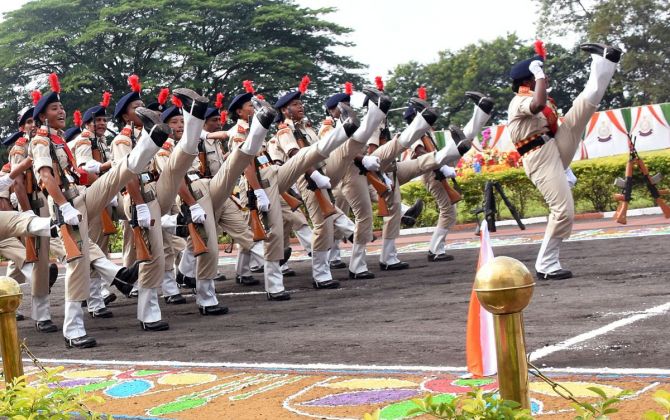The government has sanctioned a dozen fresh SSB battalions, comprising over 13,000 personnel for the Nepal and Bhutan borders guarding force, to "fortify" defences along these fronts including the tri-junction area in Sikkim that adjoins Bhutan and Tibet, officials said.

Though the Union home ministry has denied creation of a new field frontier for the border force, it has allowed the SSB to create one out of three new sector -- responsible for the operations of about 5-6 battalions -- and it is expected to come up in the Delhi-NCR region.
The Sashastra Seema Bal (SSB), with an estimated strength of about 90,000 personnel, is the designated force to guard the open Indian fronts with Nepal (1,751 km) and Bhutan (699 km).
SSB Director General (DG) Kumar Rajesh Chandra told PTI that the 12 new battalions will be raised in phases, three units each over the next four years.
"It is very supportive of the government to have given the sanction to raise new battalions and establishments for the SSB. The new manpower will ensure that border security is strengthened," the DG said.
The SSB chief added that the government has also sanctioned a total of 548 posts to the force for deployment at four ICPs (integrated check posts) along the Nepal border out of which two are already operational at Jogbani and Raxaul (both in Bihar).
"We are thankful to the home ministry as these sanctions have come at a time when no new posts are being created. We are in the process to further implement the new approvals obtained," Chandra said.
As per an official proposal of the border force approved by the ministry of home affairs (MHA), the new battalions will be used to reduce inter-border outpost distance, strengthen trade and transit routes along Nepal and Bhutan and fortifying SSB' strength in the tri-junction area in Sikkim.
The tri-junction area is the plateau between India, Bhutan and Tibet and the SSB is deployed just below it on the southern side as part of its mandate to guard the front with Bhutan.
The militaries of India and China had witnessed an over 70-day standoff in the Doklam at the tri-junction in 2017.
The new manpower will also help the SSB, as per the proposal, in upgrading the existing border posts at "strategically important" locations along the two fronts and providing armed security to the eight integrated check posts along these fronts.
Officials said the blueprint for sanction of new battalions and establishments for the force was drawn after Union Home Minister Amit Shah reviewed the operations of the SSB in October, 2019 and directed it conduct a “vulnerability assessment and gap analysis” of the two borders it secures.
The SSB, after completing this task, informed the MHA that it would require 12 new battalions, a frontier headquarter and at least three sector headquarters that would be used to enhance logistical and administrative support to its border units and some of those deployed for internal security duties in the hinterland.
However, the home ministry, approved only a sector formation and 12 battalions to be raised in phases in view of the given financial space, officials said.
A battalion has a strength of over 1,000 personnel.
The remaining two sectors and a frontier are also expected to be sanctioned by the home ministry in the next phase, they said.
A sector formation of a paramilitary or central armed police force (CAPF) is responsible for the operations of about 5-6 battalions and is headed by a deputy inspector general (DIG) rank officer.
About two-four sectors form a frontier that is headed by an IG-rank officer.










